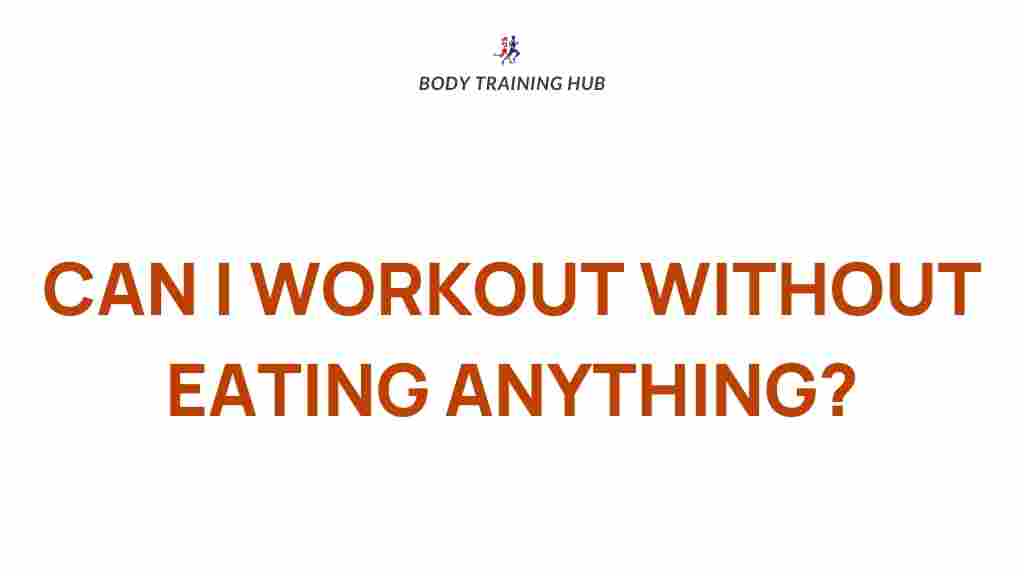Uncover the Truth: Exercising on an Empty Stomach
In the world of fitness, the debate about whether to exercise on an empty stomach or after eating has long been a topic of discussion. Many fitness enthusiasts, trainers, and health experts have varying opinions on this practice. Some swear by their morning workouts before breakfast, claiming it maximizes fat burning, while others argue that eating beforehand is crucial for optimal performance and recovery. In this article, we will explore the various myths, benefits, and impacts of working out on an empty stomach to help you make an informed decision about your fitness routine.
Understanding the Myths Surrounding Empty Stomach Workouts
Before diving into the benefits and drawbacks of exercising on an empty stomach, it’s essential to address some common myths that often cloud judgment:
- Myth 1: Exercising on an empty stomach leads to muscle loss.
- Myth 2: You burn more fat by skipping breakfast before a workout.
- Myth 3: All workouts are better performed on an empty stomach.
While each of these myths has some basis in truth, they are often oversimplified. Understanding how your body responds to exercise and nutrition is vital for optimizing your fitness performance.
Benefits of Working Out on an Empty Stomach
Many people find that exercising before consuming any food has several benefits:
1. Enhanced Fat Burning
One of the primary reasons many choose to workout on an empty stomach is the potential for increased fat oxidation. When your body is low on glycogen (the stored form of carbohydrates), it may turn to fat as a source of energy, which can be beneficial for those looking to lose weight.
2. Improved Insulin Sensitivity
Exercising in a fasted state may improve insulin sensitivity, as your body becomes more efficient at utilizing carbohydrates once you do eat. This can be particularly beneficial for those with insulin resistance or type 2 diabetes.
3. Convenience and Simplicity
For many, working out first thing in the morning without the need for a pre-workout meal can simplify their routine. It eliminates the potential for gastrointestinal discomfort that can occur when exercising soon after eating.
Drawbacks of Exercising on an Empty Stomach
While there are benefits, there are also some potential drawbacks to consider:
1. Reduced Performance
Exercising without having eaten can lead to decreased performance, especially during high-intensity workouts. Your body may not have enough immediate energy, resulting in less stamina and strength during your routine.
2. Increased Muscle Breakdown
In a fasted state, your body may also break down muscle protein for energy, particularly during prolonged or intensive exercise. This can counteract your fitness goals if muscle gain is your priority.
3. Risk of Fatigue
Working out on an empty stomach can lead to feelings of fatigue and dizziness, especially for those who are not accustomed to it. If you feel lightheaded or weak, it may be a sign to adjust your pre-exercise routine.
Finding Your Balance: A Step-by-Step Process
Determining whether to exercise on an empty stomach requires a personalized approach. Here’s a step-by-step process to help you find your balance:
Step 1: Assess Your Goals
Consider what you want to achieve with your workout. If your primary goal is fat loss, fasted workouts may be beneficial. However, if building muscle or peak performance is your aim, consider eating beforehand.
Step 2: Experiment with Timing
Try different workout times to see how your body responds. Some individuals thrive on fasted workouts, while others perform better after a light meal.
Step 3: Choose the Right Foods
If you decide to eat before exercising, opt for easily digestible foods that provide quick energy. Some excellent pre-workout snacks include:
- Bananas
- Oats
- Yogurt
- A small smoothie
Step 4: Stay Hydrated
Regardless of whether you eat before your workout, staying hydrated is crucial. Dehydration can significantly impair performance and recovery.
Step 5: Listen to Your Body
Your body is the best indicator of what works for you. Pay attention to how you feel during and after your workouts, and adjust your routine accordingly.
Troubleshooting Tips for Empty Stomach Workouts
If you decide to try working out on an empty stomach, keep these troubleshooting tips in mind:
- Start Slow: If you’re new to fasted workouts, start with lower intensity exercises to gauge how your body reacts.
- Prioritize Recovery: Focus on post-workout nutrition to replenish energy stores and promote muscle recovery.
- Mix It Up: Alternate between fasted and fed workouts to assess which works best for your body and goals.
Conclusion: Making an Informed Choice for Your Fitness Journey
Ultimately, the decision to workout on an empty stomach or after eating comes down to personal preference, fitness goals, and how your body responds to different routines. While there are benefits to fasted workouts, it is not a one-size-fits-all approach. Listen to your body, experiment with timing, and find a routine that helps you achieve your fitness objectives.
Remember, whether you choose to exercise on an empty stomach or after eating, consistency is key to success in any fitness program. For more insights into fitness and nutrition, check out this helpful resource.
For further reading about exercise and nutrition myths, visit this external link.
This article is in the category Myths & Facts and created by BodyTraining Team
